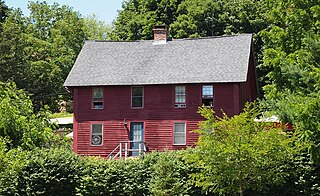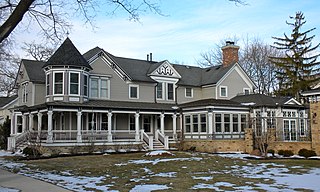Minard Lafever (1798–1854) was an American architect of churches and houses in the United States in the early nineteenth century.

The Quaker Hill Historic District encompasses the center a mainly residential village in northeastern Waterford, Connecticut. Running in a mostly linear fashion along Old Norwich Road between Connecticut Route 32 and Richard Grove Road, the area first grew as a settlement of religious non-conformists in the 17th century, developed in the 19th century as a small industrial village, and became more suburban in character in the 20th century. Its architecture is reflective of these changes, and it was listed on the National Register of Historic Places in 2002.

The South Britain Historic District in Southbury, Connecticut, United States, is a historic district that was listed on the National Register of Historic Places in 1987. It represents the central portion of South Britain, an unincorporated village. The district is bordered by the Pomperaug River on the west. Water-powered mills, supplied by water from a South Britain Water Power Company reservoir, were the impetus for early development.

The Tariffville Historic District is a 93 acres (38 ha) historic district in the town of Simsbury, Connecticut. It was listed on the National Register of Historic Places in 1993. It is part of the Tariffville section of Simsbury. The district includes 165 contributing buildings and two contributing sites. It also includes 26 non-contributing buildings and 4 non-contributing sites. There are several houses in the district of Gothic Revival style, probably following designs from pattern books of architect Andrew Jackson Downing. The Trinity Episcopal Church is the only building in the district designed by an architect of national standing, namely Henry C. Dudley. Many of the homes in the area were built by the Tariff Manufacturing Company, which opened a carpet mill along the Farmington River, and needed housing for workers.

The Belchertown Center Historic District is a historic district which encompasses the historic village center of Belchertown, Massachusetts. Centered on Belchertown's 1,200-foot (370 m) common, the district includes 55 contributing properties along South Main Street, Maple Street, and a few adjacent streets. It was listed on the National Register of Historic Places in 1982.

The Silver City Historic District is a historically significant section of downtown Silver City, New Mexico, United States.

The Old Homestead in Aberdeen, Mississippi was built in c.1852. It has also been known as Dr. George Augustus Sykes House and Julian T. Evans House. It was listed on the National Register of Historic Places in 1988. The listing includes 2 contributing buildings.

Grace Episcopal Church Complex is a historic Episcopal church complex located at Lyons in Wayne County, New York. The complex consists of a contributing stone church building begun in 1838, a contributing frame rectory begun about 1833, and a contributing parish house built in 1887–1888. The church building is Gothic Revival in style and constructed of rubble limestone walls with cut limestone trim. The rectory is an irregularly massed two story, wood frame building incorporating a former private residence built at this site about 1833 in the vernacular late Federal / early Greek Revival style. The parish house is a single story, frame building designed in the Queen Anne style.

The Barrington Historic District is a 92-acre (37 ha) historic district in Barrington, Illinois. The district encompasses a residential area in southwest Barrington and is roughly bounded by the Chicago and Northwestern Railway tracks to the north, Dundee Avenue to the west, E. Hillside and W. Coolidge Streets to the south, and S. Spring and S. Grove Streets to the east. The large majority of the district is in Cook County, but about one square block is in Lake County, Illinois.

The Carlowville Historic District is a historic district in the community of Carlowville, Alabama. The historic district covers 780 acres (320 ha) and is centered on Alabama State Route 89 and Dallas County roads 4, 47 and 417. It was placed on the National Register of Historic Places on January 18, 1978.

The Perkins-Clark House is a historic house at 49 Woodland Street in Hartford, Connecticut. BUilt in 1861, it is a prominent example of high-style Gothic Revival residential architecture, and is notable for the association of its first owner, Charles Perkins, with author Samuel Clemens. The house was listed on the National Register of Historic Places on December 14, 1978, and is a contributing property to the Nook Farm and Woodland Street District.

Hand–Hale Historic District is a national historic district located at Elizabethtown in Essex County, New York. The district contains seven contributing buildings. It encompasses the Hand House and Law Office, the Hale House and Law Office, and dependencies associated with both properties.

The Ranzow–Sander House is a historic building located in the West End of Davenport, Iowa, United States. It has been listed on the National Register of Historic Places since 1983.

Linden–South Historic District is a national historic district located in the South Wedge neighborhood of Rochester in Monroe County, New York. The district consists of 136 contributing buildings, including 82 residential buildings, 53 outbuildings, and one church. The houses were constructed between 1872 and 1913 in a variety of vernacular interpretations of popular architectural styles including Gothic Revival, Italianate, Queen Anne, and Colonial Revival styles. The houses are 2 1/2-stories, are of frame or brick construction, and were designed by local architects employed by the developer Ellwanger & Barry. Among the more prominent are Andrew Jackson Warner and Claude Bragdon. The church is the former South Avenue Baptist Church, now Holy Spirit Greek Orthodox Church, built in 1909–1910 in a Late Gothic Revival style. Also in the district is a three-story, Queen Anne style mixed use building, with commercial space on the first floor and residential units above, located at 785 South Avenue.

Helvetia Village Historic District is a national historic district located at Helvetia, Randolph County, West Virginia. It encompasses 26 contributing buildings in the village center. Some of the buildings date to the original settlement period in 1869–1870, when they were built of log construction. Later 19th-century and early-20th century buildings are of frame construction, with a number in the Carpenter Gothic style. Notable buildings include The Church (1882), Huber Inn, Post Office and Store / house (1920s), the log Swiss Museum, Star Band Hall, Cheese Haus, an original cabin (1870), Helvetia Community Hall (1939), and Rudolph's Carpenter Shop.

New Pump-House, also known as the Byrd Park Pump House, is a historic pumping station building located in Byrd Park, Richmond, Virginia. It was built in 1881–1883, and is a three-part, "I" plan, Gothic Revival style granite building. A one-story, L-shaped annex was built in 1905. The building features a steeply pitched roof, projecting gables, Gothic arches, and lancet windows. Also on the property are the contributing Beaux Arts style 1924 Hydro Electric Pumping Station constructed of brick, concrete, and stucco and the 1881 Worthington Steam Pump Building, a one-story Italianate style pump house built of brick coated with stucco. The complex was built as the waterworks for the city of Richmond.

The Joseph Keck House, is a historic building located in Washington, Iowa, United States. Joseph Keck was a native of Pennsylvania who was trained as a carpenter and eventually became a banker. He married Elizabeth Jackson in 1844. Her family owned the property the house was built on. The Kecks lived in a small house that had been built here previously. Once he received the title to the land in 1855, Keck had this house built sometime in the mid to late 1850s. The two-story brick house is a well preserved, example of French mansard residential architecture. Other architectural styles represented in the house include the Gothic balustrade and vergeboard, the Greek Revival acroterion and finial, and the Italianate porch arcade. The house was individually listed on the National Register of Historic Places in 1978. In 2018 it was included as a contributing property in the West Side Residential Historic District.

Halderman–Van Buskirk Farmstead is a historic farm and national historic district located in Paw Paw Township, Wabash County, Indiana. It encompasses five contributing buildings, one contributing site, and four contributing structure on a farm established in 1860. The farmhouse was built between 1860 and 1865, and is a 1 1/2-story, Gothic Revival style brick dwelling on a fieldstone foundation. Other contributing resources are the milk house, carriage house, dairy barn, livestock barn, corn crib, grain bin, cistern, and grain silo (1941).

The Fenelon Place Residential Historic District is a nationally recognized historic district located in Dubuque, Iowa, United States. It was listed on the National Register of Historic Places in 2015. At the time of its nomination it consisted of 218 resources, which included 171 contributing buildings, two contributing structures, one contributing site, 43 non-contributing buildings, and one non-contributing structure. The residential area that makes up the district is located on a plateau located directly above the Mississippi River Valley. This was the first bluff-top neighborhood in Dubuque that established elevator service. The first Fenelon Place Elevator, listed on the National Register in 1978, was completed in 1894. Early houses on the plateau were small cottages built by lead miners. They were replaced by large houses that were built in two periods. The first period at the end of the 19th century saw houses built in the Italianate, Gothic Revival, Second Empire, and Queen Anne styles. House in the second period in the beginning of the 20th century were largely built in the Classical Revival and Tudor Revival styles.




















